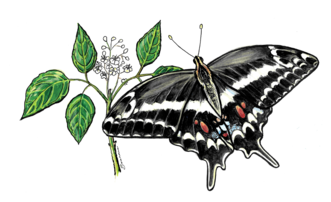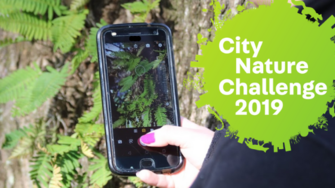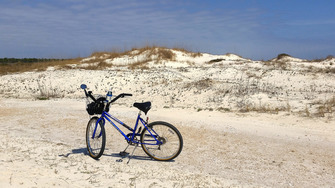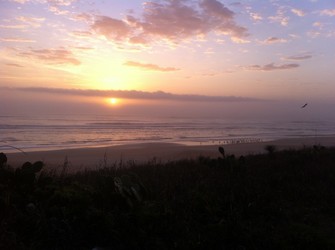 The beautiful Schaus’ swallowtail will be featured on our 2019 Butterfly Big Year certificates.
Many people are familiar with the concept of a birding big year, in which a birder tries to find as many species as possible between Jan. 1 and Dec. 31 – but have you ever heard of a butterfly big year?
The Florida Fish and Wildlife Conservation Commission (FWC) and the Florida Museum of Natural History are inviting residents and visitors to take part in the nation’s very first butterfly big year! Join other naturalists across the state in identifying and recording as many species as possible. Earn certificates for listing milestones along the way and, when 2019 comes to a close, submit your butterfly checklist to earn a Wings Over Florida Big Year certificate.
While you keep your list, follow along with us to learn more about the ecological importance of these beautiful creatures and what you can do to promote butterfly conservation, from becoming a citizen scientist to creating butterfly habitat in your own back yard.
Click here for more information about the program and for our official Wings over Florida rules; follow us on Facebook, Twitter, and Instagram for more news, facts, and beautiful photos of butterflies and other Florida wildlife!
 To help your city win the City Nature Challenge, use the iNaturalist app to record your observations.
If you live in Tallahassee or Miami, it is time to gear up for the City Nature Challenge! These two cities will be competing against 169 others across the globe, from Los Angeles to Rome to Tokyo. These cities are competing for the title of global biodiversity capital by making observations of plants and animals in back yards, parks, lakes, along city streets, oceans and in wild spaces – wherever you find nature!
There are three ways to win: making the greatest number of observations, observing the greatest number of species, and involving the greatest number of participants. All observations will be made using the iNaturalist app, which you can download today from the app store or google play to get started! Take a picture of what you see to add it to your city’s total. Even if you can’t identify a plant or animal, the iNaturalist app will help you make an educated guess by comparing your picture to its database and suggesting an ID for you!
We are hoping the challenge gets more people engaged with the incredible flora and fauna around them in their own cities - but we’re also hoping to win! As Floridian naturalists know, our state has an astounding amount of biodiversity. Tallahassee is well known for its abundance of trees, and is adjacent to the Apalachicola National Forest, famous for its diversity of plants and wildlife. Miami’s climate and location between the Atlantic ocean and Everglades make it a biodiversity hotspot.
All observations made within the cities and surrounding areas count toward your city’s total, so you can be on the lookout for nature all weekend! If you are interested in participating in an organized event led by local groups and naturalists, check out the planned activities for Tallahassee and Miami online.
Let’s put Florida’s biodiversity on the world stage!
The Tallahassee/Leon County City Nature Challenge is organized by FWC and WFSU with the help of many local partners. The 2019 City Nature Challenge: Miami and Upper Keys is organized by FIU and other partner organizations. The global City Nature Challenge is coordinated by the California Academy of Sciences and the Natural History Museum of Los Angeles County.

We love birds, and we love the habitats in which they live. We also love to travel far and wide across the diverse ecosystems of Florida to see as much as we can see - but we don't necessarily love the fossil fuels we use to get us there.
One way to lessen the environmental impact of birding is to bird locally. Many birders have started keeping "green lists" of birds they see when traveling on foot or by bicycle. Others have started keeping a 5-mile radius list, which is exactly what it sounds like - keeping a list of birds within 5 miles of your home. Not only will this reduce your carbon footprint, but it will help you become an expert on the birds near you. Getting to know a place, and to see how it changes throughout the year and across the years, can be incredibly rewarding. Spending more time in spots that are not frequently birded can also turn up brand new finds for your area! If there are no ebird hotspots near you, take a look at a map for potential new places. You may just discover a hidden gem.
We certainly aren’t saying that you should stop traveling the state in search of new species; you can’t see everything at home, and ecotourism across Florida provides strong incentives for conservation efforts (stay tuned for more on that in next month’s newsletter). Just be sure not to neglect all the exciting wildlife you can find close to home!
 Distant shorebirds and a beautiful sunrise on the beach. Photo courtesy of Celena Cline, FDEP
North Peninsula State Park, just four miles south of Flagler Beach on scenic A1A, offers multiple opportunities for birding, as well as hiking, biking and swimming. The diversity of habitats in the park means that even a short trip can yield an impressive array of wildlife, including indigo snakes, gopher tortoises and Florida Scrub Jays!
At Smith Creek Landing, you can enjoy the unobstructed view of the marsh restoration site just a short distance from the parking area. In the 1930s this area was severely impacted due to dredging associated with creating the Florida Intracoastal Waterway. The final phase of the saltmarsh restoration project was completed in 2016. The goal of the project was to create a healthy, productive saltmarsh habitat which connects to open water, benefiting an extremely wide range of plants and animals.
After birding the salt marsh, you can leave Smith Landing via the Coastal Strand Trail, an invigorating 2.5-mile hike which meanders through upland forest. Migrating birds rely on this forest for food and shelter during their long journeys. This trail is a great place to see songbirds, woodpeckers, hawks and more.
At the beachside parking area off A1A, you can stop to observe Brown Pelican, Northern Gannet, terns, gulls and numerous shorebirds along 2.75 miles of unspoiled beach.
See the eBird lists for this park here and here!
Address: 40 Highbridge Rd., Ormond by the Sea, 32176
Phone: 386-517-2086
Hours: Daily, 8 a.m. to sundown
April 4: Educational Program – Live Raptor Show (Palm Coast)
April 6: Birds of the Beach at Rookery Bay (Naples)
April 9: Corkscrew Swamp Sanctuary Lunch n’ Learn (Naples)
April 13: Hernando Audubon Society Field Trip to Goethe Forest (Levy County)
April 13: Possum Branch Preserve Trip (Clearwater)
April 14: Anastasia State Park Guided Bird Walk (St Augustine) – see listing for more dates!
April 20: Indian Lake State Forest Walk (Silver Springs)
April 24 – 28: Florida’s Birding and Photo Fest (St. Augustine Beach)
April 26: Hernando Audubon Beginning Birding (Brooksville)
April 26 – 29: City Nature Challenge 2019: Miami and Upper Keys
April 26 – 29: Tallahassee/Leon County City Nature Challenge
Check out the events page of our website for more events across the state!
Do you know about any other bird- or wildlife-related events going on in Florida? Help spread the word by letting us know! Send in the times, dates, locations and contact information to wildlifeviewing@myfwc.com for posting on the Great Florida Birding and Wildlife Trail website.
Events must be related to birds or other wildlife and must be open to the public. Examples include interpretive programming, summer camps and family programs.
|